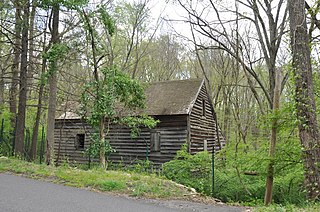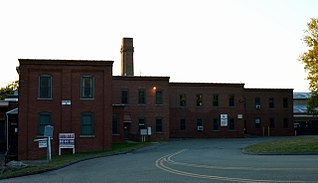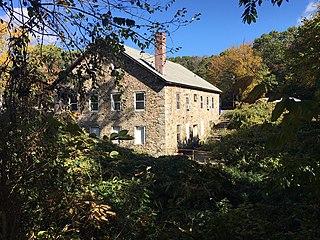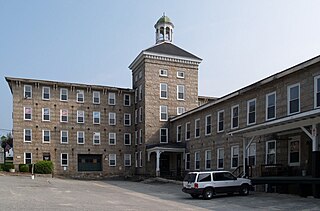
Killingly is a town in Windham County, Connecticut, United States. The population was 17,752 at the 2020 census. It consists of the borough of Danielson and the villages of Attawaugan, Ballouville, Dayville, East Killingly, Rogers, and South Killingly.

The Saxony Mill was a historic textile mill complex at 66 West Street in Rockville section of Vernon, Connecticut. With a construction history dating to 1836, it was one of the oldest surviving wood-frame textile mills in the state prior to a 1994 fire which led to its demolition. The mill complex was added to the National Register of Historic Places in 1983.

The Russell Company Upper Mill is an historic structure in Middletown, Connecticut, built in 1836 and listed on the National Register of Historic Places. The building stands at the junction of Russell Street and East Main Street in South Farms. There is a small pond to the south. East Main Street's commercial and industrial development ends there. To the north, small businesses border the street, followed by the buildings of Russell Manufacturing Company, the area's most dominant feature. Russell Street crosses Sumner Brook nearby and ascends to a large residential district to the west. The mill is currently a condo-apartment complex.

The Talcottville Historic District is a historic district in the town of Vernon, Connecticut. Centered on Elm Hill Road and Main Street, it encompasses a 19th-century mill village, including archaeological remnants of very early cotton-spinning facilities, and old stone dam, and a major wood-frame mill constructed by the Talcott brothers. Also included in the village are a significant number of mill worker housing units, many dating to the middle decades of the 19th century, and an 1891 lenticular pony truss bridge, built by the Berlin Iron Bridge Company. The district was listed on the National Register of Historic Places in 1989.

The Russells Mills Village Historic District is a historic district on Russells Mills, Rock O' Dundee, Slades Corner, Horseneck and Fisher Roads in Dartmouth, Massachusetts. It encompasses an area that was an early industrial center, flourishing from the 18th century into the early 19th century. The district was added to the National Register of Historic Places in 1985.

The Bisbee Mill is a historic gristmill at 66 East Street in Chesterfield, Massachusetts. Located on the Dead Branch of the Westfield River, the mill complex includes a wood frame mill building, along with its former mill pond, impounded by a dam across the river, and a canal that brought river water to the mill for power. Also included on the property is the site of the Damon sawmill, which was established in 1761, and the Pierce cornmill, which occupied a site north of the Bisbee mill building in 1823. The Pierce mill was moved to the site, from an earlier one that may also be on the grounds of the Bisbee mill complex.

The North Canal Historic District of Lawrence, Massachusetts, encompasses the historic industrial heart of the city. It is centered on the North Canal and the Great Stone Dam, which provided the waterpower for its many mill complexes. The canal was listed on the National Register of Historic Places in 1975, while the district was first listed in 1984, and then expanded slightly in 2009.

The New Hope Mills Complex is a historic grist mill complex located on Glen Haven Road near the intersection with Route 41A in the hamlet of New Hope in the town of Niles in Cayuga County, New York. The complex includes the mill building, two vernacular dwellings, a 1910s gambrel roofed storage barn, a 1935 saw mill, two concrete faced dams, and a 1-acre (4,000 m2) mill pond.

The Occum Hydroelectric Plant and Dam is a historic hydroelectric plant and dam north of Bridge Street on the west side of the Shetucket River in Norwich, Connecticut. The facility includes a rare surviving partial example of a large-scale dam built for a textile mill in 1865, and an early example of a hydroelectric power generation facility established in 1934. It is one of a small number of surviving hydroelectric plants in the state which was built before 1940. The complex was listed on the National Register of Historic Places in 1996.

The New York Belting and Packing Co. complex, also known locally for its main 20th-century occupant, the Fabric Fire Hose Company, is a historic industrial complex at 45-71, 79-89 Glen Road in Newtown, Connecticut. Its centerpiece is a four-story brick mill building with an Italianate tower, built in 1856. The property also includes a dam impounding the adjacent Pootatuck River, a mill pond, and a hydroelectric power generation facility.

The Sylvanus Selleck Gristmill, also known as the Edwin Knapp Gristmill, is a historic gristmill at 124 Old Mill Road in Greenwich, Connecticut. Built about 1796, it is one of the oldest mill buildings in the state, and a rare surviving example of brace-frame construction. It was listed on the National Register of Historic Places in 1990.

The Lermond Mill, now also known as Morgan's Mill, is a historic mill complex on Payson Road in Union, Maine. With a history dating to the late 18th century, and its present buildings from the early 19th century, it is one of the oldest operational water-powered mills in the state of Maine. It was listed on the National Register of Historic Places in 1984. As of 2006, it was reported to be in use for power generation and as a grist mill.

The Bridgewater Woolen Mill, now more commonly the Bridgewater Mill Mall, is a historic textile mill complex on United States Route 4 in Bridgewater and Woodstock, Vermont. With an textile processing history dating from 1828 to 1975, it was one of the state's longest-lived textile operations, and was a mainstay of the local economy during that period. It has since been repurposed into a shopping center. It was listed on the National Register of Historic Places in 1976.

The Broad Brook Company was a manufacturer of textiles in East Windsor, Connecticut, which operated from the 1830s until 1954. The company plant, located on Broad Brook at Main Street and Scott Road in the town's Broad Brook village, was listed on the National Register of Historic Places in 1985. Partially destroyed by fire, with surviving buildings converted into residential condominiums in the 1980s, the complex has been shuttered due to the discovery of toxic soil conditions on the property.

The Case Brothers Historic District encompasses a complex of homes, business, and recreational properties belonging to a prominent papermaking family in Manchester, Connecticut. The Case family owned and operated a paper mill from 1862 until 1967, built architecturally sophisticated residences, and minimally developed what is now the Case Mountain Recreation Area, a rustic public park in southeastern Manchester. Their properties were listed on the National Register of Historic Places in 2009.

The Otis Angell Gristmill is a historic mill in Governor John Notte Memorial Park, North Providence, Rhode Island. Built about 1855, it is a well-preserved example of a small 19th-century industrial site, with a stone mill building and a small mill pond. The site was added to the National Register of Historic Places in 2017. The mill building now serves as a local community center.

The Cargill Falls Mill, also known historically as the Wilkinson Mill, is a historic textile mill complex at 52-58 Pomfret Street in Putnam, Connecticut. Founded in 1806, it is one of the state's oldest mill complexes, and it retains examples of mill architecture spanning more than 175 years. It was listed on the National Register of Historic Places in 2014.

The Manchaug Village Historic District is a historic district encompassing the 19th century industrial village center of Manchaug in Sutton, Massachusetts. Developed in the 1820s around textile mills on the Mumford River, it was the largest industrial area in Sutton, with at least three mill complexes in operation. The district is centered on the junction of Main Street with Manchaug, Putnam Hill, and Whitins Roads.

Lumsdale Valley is a steep-sided wooded gorge in the Peak District near Matlock, Derbyshire, in England. It is the location of a series of historic water-powered mills.

The Wooster Sawmill and Gristmill Site is a historic industrial site on Park Street in Oxford, Connecticut. From at least 1747 until 1965 it was operated as a sawmill, gristmill, and cider mill, giving it one of the longest known histories as a water-powered mill complex in the United States. The surviving elements of the complex, its structures now converted to private residential use, were listed on the National Register of Historic Places in 2001.






















